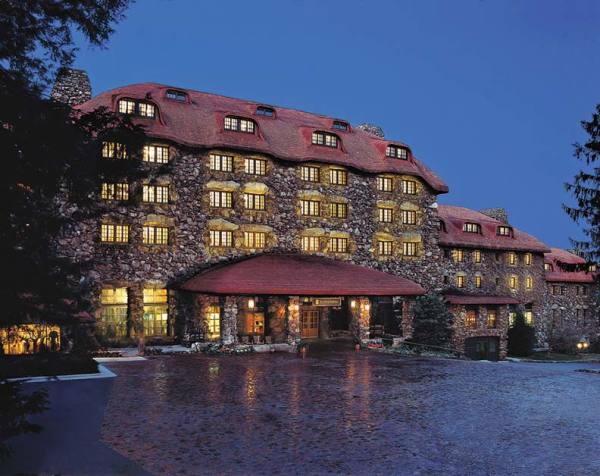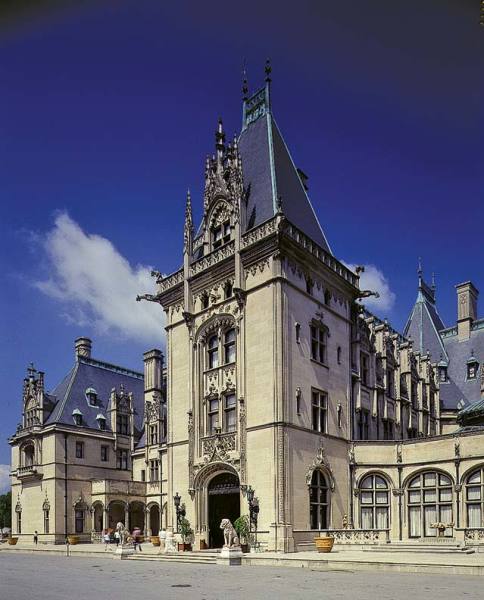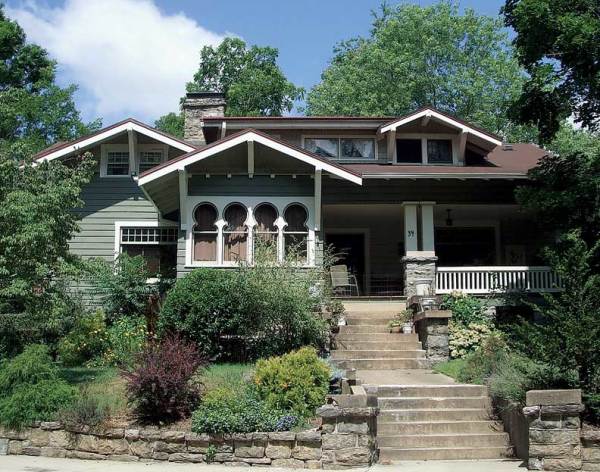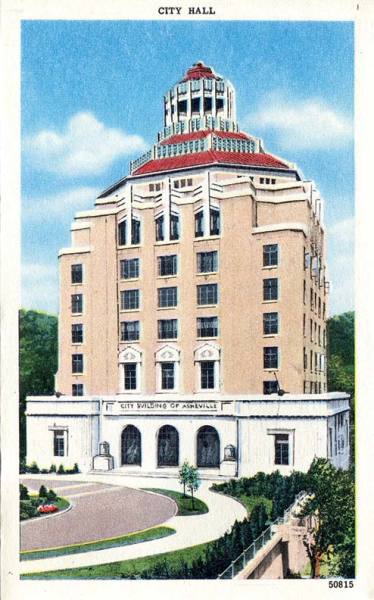
The Grove Park Inn remains an Arts & Crafts icon and a mecca for the movement’s enthusiasts.
Asheville, North Carolina, is a city flanked by two famous bookends: the 1895 Biltmore Estate and the 1913 Grove Park Inn. Gilded Age Victorian to the south, austere Arts & Crafts to the north.
In between, like a collection of books, is an array of architectural delights—from Queen Anne and Colonial Revival to English Tudor and Art Deco, with enough bungalows mixed in to earn it the distinction of Arts & Crafts capital of the South. Combined, they create a city that’s delightful to explore by car or by walking through the quirky, artsy, active downtown.
As cities go, Asheville was a late bloomer. Nestled in the lush French Broad River Valley and completely surrounded by the imposing Blue Ridge Mountains, it wasn’t until the arrival of the railroad in 1880 that word spread of its healing effects. The city’s warm natural springs, clean mountain air, hiking trails, panoramic views, brief winters, cool summers, and extended spring and fall seasons soon brought a steady stream of exhausted businessmen, Washington politicians, and curious tourists via the Southern Railway.
The combination of Asheville’s location and its moderate yet distinctive seasons has resulted in its becoming a year-round tourist destination. Southerners come to escape heat and humidity, Northerners to avoid snow and ice. Together, they strengthen the local economy and support the trendy restaurants and upscale galleries unusual for a city of just 83,000 residents.
The Biltmore Estate

The grand Biltmore Estate has been a tourist attraction for a hundred years.
Among the city’s early arrivals was George Vanderbilt II, who became so enchanted with Asheville that he spent nearly his entire inheritance on the 125,000-acre estate and 250-room manor he christened Biltmore. Designed by Richard Morris Hunt and modeled after a chateau the two men had toured in the Loire Valley, the Biltmore mansion and grounds replicated a working French estate. Vanderbilt spared no expense in its design, which included an indoor pool, bowling alley and exercise room, elevators, forced-air heating, and an intercom system—all considered revolutionary in 1895. Still family-owned, fully restored, and expanded to include a winery, world-renowned gardens, a hotel, several restaurants, and numerous outdoor activities, the Biltmore Estate attracts more than a million visitors to Asheville each year.
Just outside the estate’s gate is the picturesque Biltmore Village, a collection of stucco-and-half-timbered buildings designed by Hunt’s assistant, Richard Sharp Smith, a dapper and refined Englishman who became Asheville’s most prolific Arts & Crafts architect. Once home to Vanderbilt’s employees, Biltmore Village’s buildings have been restored as gift shops, restaurants, and art galleries beneath leafy oak, maple, and sycamore trees.
The Grove Park Inn
Pharmaceutical manufacturer Edwin Wiley Grove arrived in Asheville in 1898 on his doctor’s orders and, like many of us, fell in love with this mountaintop city. Grove developed a number of Arts & Crafts neighborhoods before placing a jewel atop Asheville’s Sunset Mountain—the Grove Park Inn. He turned to his son-in-law, Fred Loring Seely (a friend and client of Roycrofter Elbert Hubbard), for the design of the 150-room resort. Seely created an Arts & Crafts masterpiece sculpted of granite boulders collected from Grove’s 1,200 acres of land, and topped it with a natural red clay roof. As a result, the hotel looks, from a distance, as though it has risen out of bedrock.
Completed in 1913 and furnished by the Roycrofters of East Aurora, New York, the Grove Park Inn at once became known as “the finest resort hotel in the world.” Today it’s become a mecca for Arts & Crafts enthusiasts who yearn to relax in the Stickley, Roycroft, and Limbert settles, rockers, and Morris chairs filling the cavernous Great Hall and spilling out into the nearby hallways. The addition of a restored Donald Ross golf course and a world-class spa, plus the national Arts & Crafts Conference each February, enhance this historic hotel’s cachet.

Montford is one of Asheville’s many walkable neighborhoods, and includes such architectural gems as the Asian-flaired Arts & Crafts Keyhole House.
Asheville’s Neighborhoods
Ask a local what makes Asheville special, and you’ll often hear this simple answer: the neighborhoods. Laid out on lazy, winding streets with small lots, Asheville’s cozy neighborhoods blossomed during the Arts & Crafts era, and remain as popular today as they were a hundred years ago. Walking down the streets of Norwood Park, Kenilworth, Albemarle Park, Grove Park, Beaver Lake, or Montford is like navigating the pages of a bungalow picture book.
A stroll down Montford Avenue through the city’s first historic district lets you witness the career of Richard Sharp Smith unfold before your eyes. His early Queen Anne turrets give way to sprawling bungalows with wraparound porches, anchored to the ground by fieldstone foundations and square balustrades that resemble a Gustav Stickley spindle settle. Twenty years ago, many of Smith’s homes were boarded up and neglected. Today, without exception, they all have been meticulously restored, with some of the larger ones carefully transformed into scrumptious bed-and-breakfast inns.
The gateway to north Asheville’s Arts & Crafts district is Albemarle Park, another turn-of-the-century historic district. While cars no longer can squeeze through the arched entrance beneath the antique Gatehouse, the drive up the slope of Sunset Mountain feels like a journey back in time. Narrow streets, granite retaining walls, and fieldstone-lined swales make this neighborhood a fit walker’s delight, its eclectic mixture of homes—from rustic cabins to English Tudors, and even a Richard Sharp Smith brick Georgian home called Breezemont—creating a dazzling texture of architectural styles.

The Ellington-designed City Hall, with its octagonal roof, is an Art Deco masterpiece. (Vintage postcard courtesy of Bruce Johnson)
Art Deco Relief
When architect Douglas Ellington arrived in 1926, fresh from the Beaux Arts Academy in Paris, Asheville was swimming in cash. Looking for something fresh and exciting, civic leaders embraced Ellington’s proposed city building in the urban and colorful Art Deco style. He soon was under contract to design an Art Deco church, restaurant, public school, and fire station all within a mile of downtown Asheville, all of which were completed just months before the stock market crash of 1929. Well-constructed, this color feast of pinks, blues, and greens initially seemed out of character in this mountain Arts & Crafts city, but the buildings remain popular to this day—a reflection, perhaps, on the equally eclectic collection of people who now call Asheville their home.
Bruce Johnsondirects the annual Arts & Crafts Conference and Antiques Show at the Grove Park Inn, and operates the website artsandcraftscollector.com.







